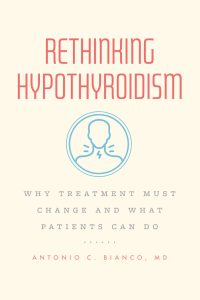Read an Excerpt from “Rethinking Hypothyroidism” by Antonio C. Bianco, MD
Hypothyroidism affects approximately five out of a hundred Americans, and hundreds of millions worldwide. It occurs when the thyroid gland malfunctions or after thyroid surgery, causing thyroid hormone levels in circulation to drop. Thus, treatment is aimed at bringing these hormone levels back to normal, usually with daily tablets of thyroxine or T4. While most patients respond well, about ten to twenty percent (some one and a half to three million individuals in the United States) are far from living a typical life. Instead, they exhibit “foggy brain”—low energy, confusion, and poor memory. In Rethinking Hypothyroidism, Dr. Antonio C. Bianco, a physician and scientist who has studied hypothyroidism and thyroid hormones for decades, offers an accessible overview of the disease’s treatment, making the case that the current approach is failing many patients. Bianco calls for alternatives to improve lives, and he equips patients and their families with the tools to advocate for other therapies.
Read on for an excerpt from the introduction of Rethinking Hypothyroidism: Why Treatment Must Change and What Patients Can Do.
The story of hypothyroidism treatment presents a solution, followed by a mystery. Why did so many of those treated for hypothyroidism ultimately fare so poorly? How was a century-long medical triumph transformed into a tarnished victory, fraught with conflict and exhaustion? Why did doctors dismiss the millions of patients insisting their treatments were failing; and why did patients find themselves suddenly doubting decades of reliable, tested science? How did the case of hypothyroidism backtrack from “closed” to “open”? Most important, what can these patients who continue to suffer do? This book tells that story.
***
We start with the thyroid gland itself. There are several glands in our body, and the thyroid is one of them. Glands typically function by producing substances known as hormones that are released into the bloodstream. These hormones travel through the blood and reach distant organs, where they can regulate functions as diverse as blood levels of glucose, salt concentration, and blood pressure.
First sketched as an organ by Leonardo da Vinci in the early sixteenth century and named by the English physician Thomas Wharton in 1656, the thyroid is a small gland located in the neck, right above the front of your shirt collar. It is shaped like a butterfly, weighs less than an ounce, and is not easily identified unless it is enlarged.
The thyroid gland takes up and concentrates the iodine that you normally ingest with meals and uses it to make thyroid hormones. The gland also releases into the circulation small amounts of its hormones throughout the day and night to regulate bodily functions. Additionally, it keeps a large storage of premade hormones that could sustain normal secretion for months, just in case you go through a period of reduced iodine intake.
Thyroid hormones affect virtually every organ in your body, accelerating the overall metabolism—your appetite and the rate at which you burn calories. These hormones also affect your memory, as well as the way you behave and think. Women will not become pregnant, and children will grow slowly or not at all without appropriate amounts of thyroid hormones. When the thyroid gland fails, a child may end up having a lower IQ and other neurological problems, and an adult will develop a disease known as hypothyroidism. Patients with hypothyroidism experience fatigue and sluggishness, sleep more than normal, have issues with the skin and hair, and gain weight.
***
What scientists have learned over the last century about the thyroid gland is fascinating, and their efforts have resulted in two Nobel Prizes in Physiology or Medicine. The Swiss surgeon Theodor Kocher received the Nobel Prize in 1909 for his work on the physiology, pathology, and surgery of the thyroid gland; in 1977, two neuroscientists, the French American Roger Guillemin and the Lithuanian American Andrew V. Schally split half the prize for their discoveries of how the brain controls thyroid function.
Our story starts at the turn of the nineteenth century, when endemic goiter (an enlargement of the thyroid) and what was called cretinism (an irreversible developmental delay caused by congenital or neonatal hypothyroidism) were common and scientists were studying the possible connection between both. Later, those investigating the gland realized that a healthy thyroid gland secretes hormones that affect every aspect of the body. Thus, the disease hypothyroidism occurs whenever the thyroid gland is not working or is surgically removed, and consequently, the levels of these hormones in the blood drop below normal range. Low levels of thyroid hormones are what cause the well-known symptoms related to hypothyroidism.
To reverse these symptoms, patients in those early days were treated with extracts of the thyroid gland obtained from sheep, cows, or pigs. This approach was developed in the 1890s and lasted through the better part of the twentieth century. The extracts contained a mixture of hormones that hypothyroid patients couldn’t produce on their own, later known as T4 and T3, each a collection of four or three iodine atoms, respectively.
Today’s conventional treatment for hypothyroidism also aims at normalizing the circulating levels of these hormones. However, it does so with only one of these crucial hormones, T4, created in a laboratory and administered at a precise dosage. What is the rationale for replacing a mixture of T4 and T3 with only T4? After absorption into the bloodstream, your body transforms T4 into T3, the main active hormone that resolves the symptoms of hypothyroidism.
It was only after the standard of care became treatment with T4 only that we see reports of dissatisfaction by fully treated patients with hypothyroidism. At the time this change in the approach to treat hypothyroidism was happening, many patients complained as they were being switched to therapy with T4. Based on interviews with my colleagues who were treating patients in the 1960s and 1970s, approximately one-quarter of the patients placed on T4 requested to return to thyroid extract or did not switch at all. Nonetheless, the switch moved forward unabated, and today, T4 is among the top prescription medicines in the United States, with annual sales of billions of dollars worldwide.
In retrospect, I can’t help but wonder why most of us ignored these early warnings and so easily wrote off patients’ complaints without questioning the effectiveness of T4. How this happened is a fascinating story that evolved over the last two hundred years, with all the ingredients of an exciting drama. It involves an incapacitating disease that predominantly affects women; an effective low-tech treatment (thyroid extract) that had potency problems and was vilified and abandoned in favor of a lucrative synthetic molecule; top-notch medical research and discoveries that backed up this new treatment and swayed medical opinion; a culture of patient dismissal; and, of course, money and pharmaceutical influence.
This is the story of hypothyroidism. And it is the story of this book.

Antonio C. Bianco, MD, is professor of medicine and a member of the Committee on Molecular Metabolism and Nutrition at the University of Chicago, where he runs a laboratory funded by the National Institutes of Health to study thyroid hormones. Bianco is also a former president of the American Thyroid Association.
Rethinking Hypothyroidism is available now from our website or your favorite bookseller.
